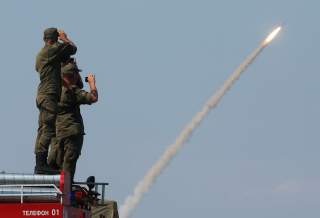RIP INF: The End of a Landmark Treaty
Donald Trump did not have to withdraw from the INF Treaty. But now that he has set the wheels in motion, what does that mean for America's national security?
Pentagon officials suggested that the plan to build a new nuclear-armed sea-launched cruise missile (SLCM) could be suspended if Russia came back into compliance. That probably did not have much effect on Moscow’s calculations, especially if Russian officials read the 2018 Nuclear Posture Review, which laid down additional conditions: “If Russia returns to compliance with its arms control obligations, reduces its non-strategic nuclear arsenal, and corrects other [unspecified] destabilizing behaviors, the United States may reconsider the pursuit of a SLCM.”
Washington could have adopted a more robust military response. The U.S. military could have moved conventionally-armed Joint Air-to-Surface Strike Missiles (JASSMs) to Europe along with B-1 bombers to serve as delivery platforms. It could have increased the number of conventionally-armed SLCMs in European waters, for example, by sending the USS Florida, a converted ballistic missile submarine that can now carry up to 154 SLCMs, on a cruise in the North and Norwegian Seas, with port calls to let everyone know it was there. Such steps could have been done quickly with existing capabilities, would have fully complied with U.S. treaty obligations, and would have caught the attention of the Russian military.
The U.S. government also could have treated with greater seriousness the Russian charge that the Aegis Ashore deployment in Romania of an Mk-41 launcher system for SM-3 missile interceptors was inconsistent with the treaty. An Mk-41 launcher on a U.S. warship can carry lots of other weapons, including cruise missiles; Russian officials contended that it was a prohibited launcher of land-based intermediate-range missiles. U.S. officials should have made clear to their counterparts that, if they would seriously address U.S. concern about the 9M729, then the U.S. side would deal with the Russian concern about the Mk-41.
Would these political and military steps have succeeded? We will not know, because Washington did not try. If Trump administration officials had a serious game plan for implementing the December “integrated strategy” to bring Russia back into compliance, then that plan was not apparent. That may be explained by John Bolton becoming National Security Advisor in April. A long-time critic of arms control in general, and of the INF Treaty in particular, Bolton probably was just as happy abandoning the treaty.
One other issue has arisen: Chinese intermediate-range ballistic missiles. The need to balance against those missiles has been cited as a reason for why the United States is leaving the treaty, but it is unclear if the Pentagon has even decided that it has a requirement for land-based intermediate-range missiles in Asia. In 2017, the vice chairman of the Joint Chiefs of Staff told a Senate panel that the United States could counter China with air- and sea-based weapons.
R.I.P. INF Treaty
To be sure, Russia committed an egregious violation. The United States could not be expected to remain in the treaty indefinitely under those circumstances. Those who support withdrawal are correct on that point.
However, Trump did not have to withdraw from the treaty at this time, especially when there were political and military measures to apply pressure on Moscow—measures that might have persuaded Russia to come back into compliance. Unfortunately, now we will not know if that tactic would have worked. Instead, the president has delivered a gift to the Russians, who will soon be able to deploy, without constraint, intermediate-range missiles for which the U.S. military has no land-based counterpart. As a bonus for Moscow, Washington will catch the international political flack for the treaty’s demise.
Steven Pifer, a William J. Perry fellow at Stanford and nonresident senior fellow with the Brookings Institution, worked extensively on intermediate-range nuclear forces issues in the 1980s in Washington, Geneva and Moscow.
Image: Reuters

